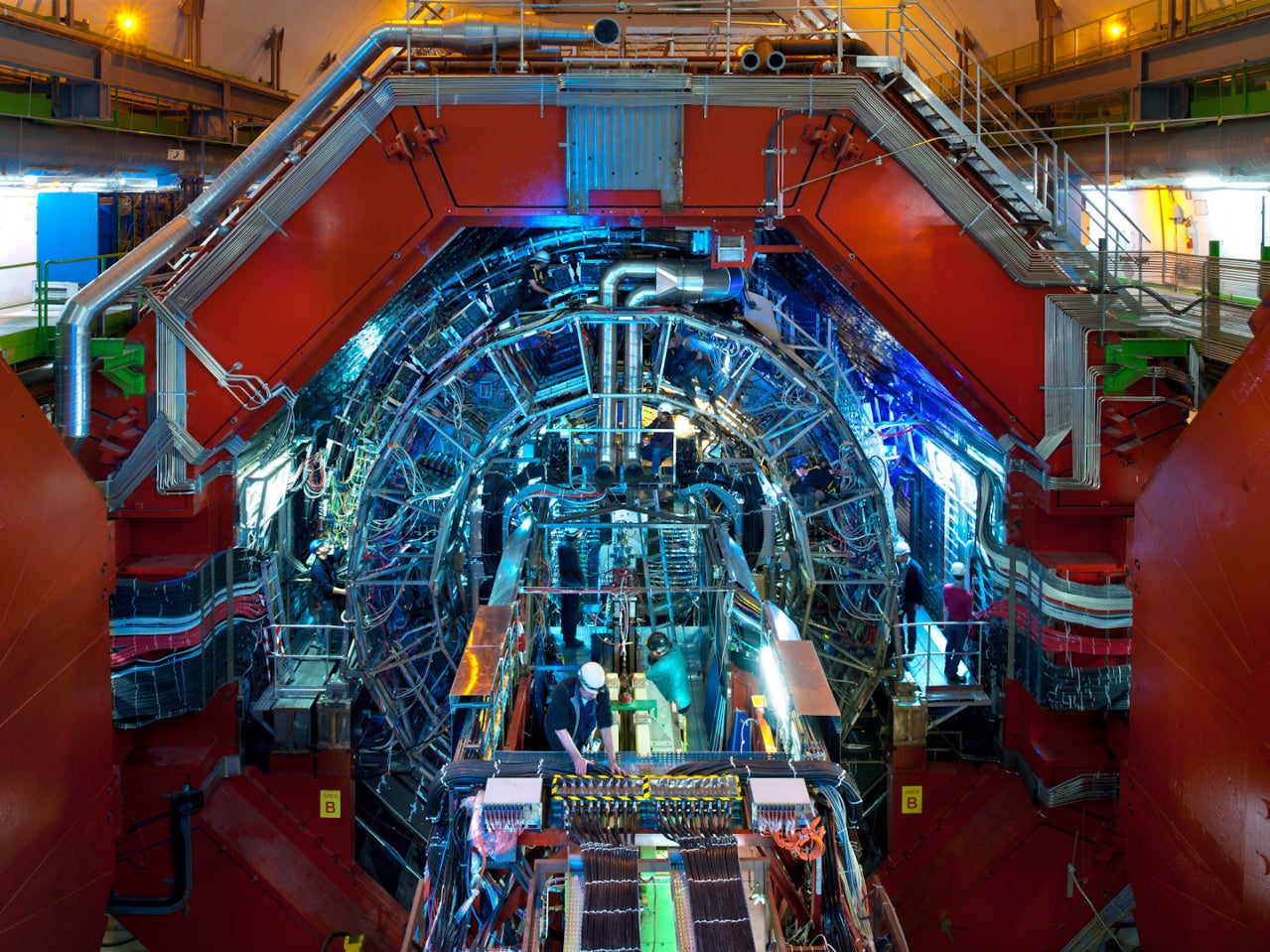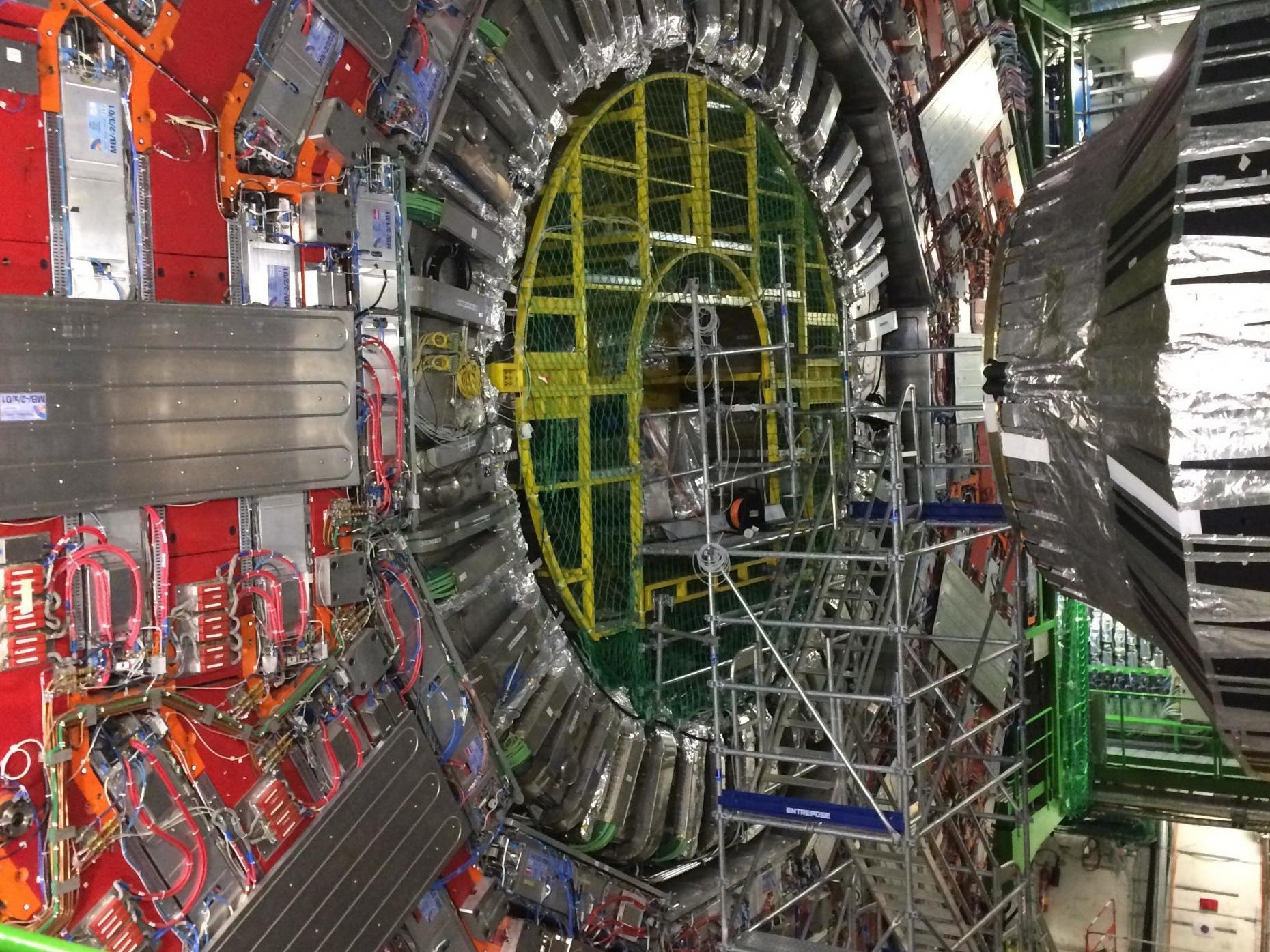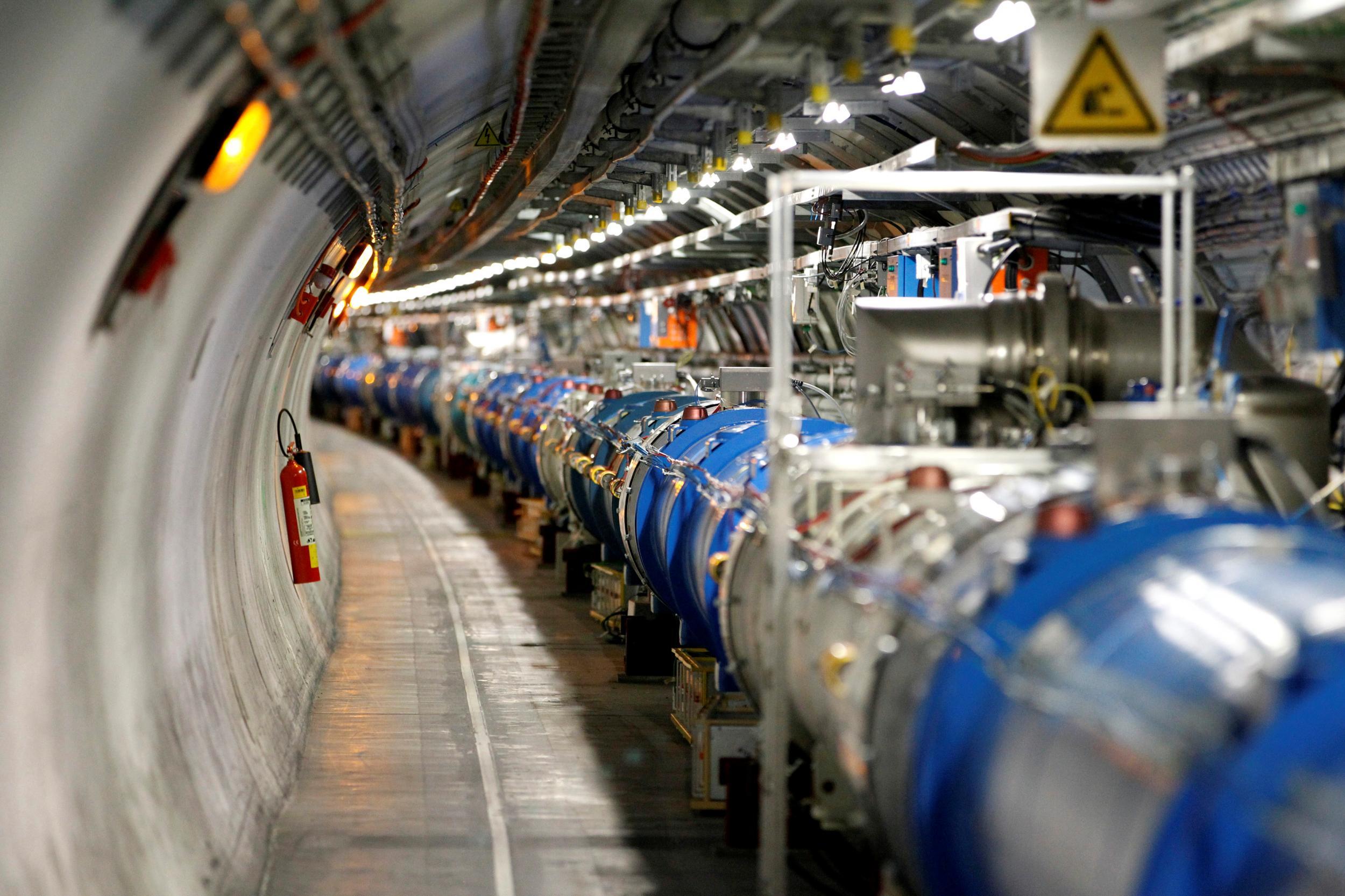Inside the Large Hadron Collider: Cern’s pursuit of the elusive god particle
Andy Martin climbs into the belly of the beast and asks why the work to unravel the mysteries of quantum mechanics is so important


I’m looking for the god particle,” I said.
“You shouldn’t say ‘god particle’,” said Dr Sarah Williams. “It’s the Higgs boson.”
“OK, can I see the Higgs boson then?”
She didn’t quite say yes and no, in a paradoxical, Schrödinger’s cat way, but it was close: “By the time we get to see it, it’s already gone.”
This is the kind of conversation you can have in only one place in the world, at Cern in Switzerland, in the realm of the Large Hadron Collider, the biggest, fastest accelerator (or “atom-smasher” as we used to say) on the planet, a particle race-track buried 100 metres under Geneva.
The LHC – as the natives call it – is currently in shutdown mode while it’s being checked over, dusted down and renovated. The loose constellation of atoms that make me up (precariously held together for the time being by electrostatic forces) were therefore able to roam freely through the 27km-long tunnel.
Wandering around underground, gazing in awe at colossal, intricate feats of engineering, I hit a top speed of 4mph. To catch up with the specks of matter that generally spin around the track, I would have to be doing 11,000 circuits in one second.
When they get into top gear, vanishingly nanoscopic protons, the nuclei of hydrogen atoms, are travelling at 99.999 per cent of “c” – only walking pace behind the speed of light itself. But some are going clockwise while others go counterclockwise. With a certain amount of persuasion, they will smash into one another with an energy that echoes the Big Bang, some 13.7 billion years ago.

Thus causing Dr Sarah Williams and some 2,000 other scientists to contemplate and puzzle over the mysteries of creation all over again. The Higgs boson, or “god particle” in the vernacular, is their greatest discovery to date.
Cern (or Centre Europeen de Recherche Nucleaire) predates the LHC. Its genesis goes back to the immediate post-war period and the “Brain Drain” that threatened to siphon off our best scientists. It was dedicated, in the midst of the Cold War, to the peaceful pursuit of pure knowledge rather than the masterminding of increasingly apocalyptic weaponry. Nuclear, yes, but nothing to do with Hiroshima.
The Large Hadron Collider, which is now the jewel in the crown, was first mapped out in the 1980s: digging the hole began in 1994, and the on-switch of the largest machine ever made was thrown in 2008, to international applause – and perhaps a degree of consternation. What we dreamed of was a portal to a parallel universe, what we feared was the end of the world as we knew it, as some rogue black hole gobbled up the solar system.
The reality was that, a few days later, the whole grand apparatus blew an immense fuse (the “magnet quench incident”), had to be switched back off again and remained out of action for over a year. E=mc² means that very small but pesky particles going off-piste can cause big trouble.
“That was a bummer,” says Paul Collier, who was the new director of Cern at the time. “We went from the greatest high to the greatest low.” Undeterred, the particles were soon back doing their ultra-relativistic marathons before exploding into exotic smithereens. On 4 July 2012, a press conference was held in an auditorium at Cern (even their own scientists had to queue up to 12 hours to get in) to announce that the elusive Higgs boson had been found.
Professor Peter Higgs (of Edinburgh University) – with other scientists – had first predicted the existence of the particle in a 1964 paper. Nearly 50 years later it had finally been proven. What made the Higgs (which is how most people here talk about it) so distinctive among so many other elementary particles is that it is like the ring to rule over the other rings. Without it, the other particles would have no mass. We would have no mass. We would be a quintessence of dust... at least you wouldn’t need to hit the gym to work off the pounds.
The surprise for me was that Cern scientists are less impressed by the Higgs boson than the Higgs field. In fact there are two Higgs fields. One is a cricket pitch at Cern for expatriates and enthusiasts. The other one is what gives us mass. The boson is just “a quantum excitation of the field”. The field, as Wordsworth puts it so neatly, is “something more deeply interfused that … rolls through all things”. Or it doesn’t so much roll through them; we roll through it.
One of its discoverers compared it to a field of snow: if you can ski over it very fast then you are light and have little mass, if you’re trudging about in boots, then you have greater mass. But it is of course invisible snow, something like the force in Star Wars. There is, to date, only one machine in the world that can produce and detect a Higgs boson. And I was in the belly of the beast.
One way of thinking about modern physics is as follows. Take your phone and click on your map app. Pinch your fingers and zoom out as far as you can go. It stops maybe around Europe. Or possibly Europe and Asia combined. Now imagine you could keep on zooming out further and further.

You can see the whole planet, then the solar system, then the galaxy, then all the other most remote galaxies together with black holes and supernovae and embryonic gas clouds, with perhaps faint ripples in space-time emanating from the Big Bang. Here (if you could do all that) you would have cosmology, the science of the maximum.
Now try zooming in again – keep expanding the fingers – and you can find a street or café. But don’t stop there. Suppose you could keep on going, zeroing in on a particular table and chair and then burrowing down still further into its atomic structure, and then on and on right into the secret inner sanctum of the atom, the nucleus, and its constituent quarks and the gluons that hold them together. There you would have particle physics, the science of the minimum. Zoom in and zoom out: from the minutest quanta of matter, barely one notch up from non-existence, to the totality of everything that ever existed in time and space.
But of course the analogy breaks down because, unlike with a phone app, it is frustratingly hard, perhaps impossible, to “see” the most fundamental constituents of time and space. Although (given the space/time crossover) we can look back billions of years at the earliest stars using our most powerful telescopes, the Big Bang itself (together with the first few hundred thousand years) is shrouded in a hazy paucity of photons. Elementary particles are similarly inaccessible to even to the most powerful microscope.
The boson does not resemble a small cricket ball or cranberry. It’s more like a vibration or fluctuation in the ether. Its vanishingly ephemeral existence has to be inferred from the tracks or traces it leaves behind.
Theory has expanded to fill the void. We cannot entirely escape theory. We need theory. As soon as we open our mouths or put pen to paper or conjure up a mathematical equation, we are shrinkwrapping reality in theory. But we can cut the plastic down to a minimum by putting our theories to the test. This is why Cern exists. It is the Supreme Court of science. The LHC is the Coliseum in which gladiatorial hypotheses must live or die. A very scientific thumbs up or down.
Take two sewing needles. Place them on opposite sides of the Atlantic. One in New York, the other in Penzance. Now try to fire them at one another so that they meet mid-Atlantic. It’s hard
It was the Greeks that gave the atom its name. A-tom, meaning, it cannot be cut, or indivisible. But Ernest Rutherford, at the turn of the 20th century, was able to cut it up still further, using radioactivity, into subatomic particles. You can’t use a knife, not even one studded with diamonds.
The only thing sharp enough to chop up a particle is another particle. The so-called Standard Model with its circus of elementary particles – which now includes the Higgs boson – grew out of that work. And the accelerator – and finally the Large Hadron Collider – was the ultimate test tube, the natural habitat of up quarks and down quarks.
Kitted out with a hard hat and an emergency oxygen supply, like some deep-sea diver, I found myself colliding with a lot of the human beings who keep the inhuman stuff under close surveillance.
“What is the smallest thing?” is the question that haunted Dr Pippa Wells as a kid. And it still does. Growing up in Leeds, she first came across atoms, aged 11, in a chemistry textbook. From the beginning they were linked in her mind to stars in the night sky. The smallest things had to be involved in the formation of the biggest things. She studied at Cambridge and now works on the Atlas project, sometimes crawling around in the tunnel at night, like a plumber trying to fix leaks. She was one of those whose work contributed to the discovery of the Higgs.

“It’s all about creating particles – and the particles we don’t yet know about,” she says. She reckons that “international collaboration is in the DNA of Cern” (there are 23 member states with observers from America, Japan, and Russia) and the great thing about working 100 metres down is that “there are no borders down there – and the particles wouldn’t take any notice of them if there were, they’re going too fast”.
I found Glyn Kirby doing some vacuuming. “Dust is our biggest enemy,” he explains. He is the Magneto of Cern, the magnet meister. He used to work at Sellafield, then Oxford Instruments. “I came here for a couple of years and I’m still here 25 years later,” he says.
You’d think magnets might slow things down a bit, but in fact they are central to speeding up and steering particles with electric fields that slingshot them forwards and keep them on-piste.
Take two sewing needles. Place them on opposite sides of the Atlantic. One in, say, New York, the other in Penzance. Now try to fire them at one another so that they meet mid-Atlantic. It’s hard. Much harder than Robin Hood’s old trick of splitting the arrow with another arrow. But this, very approximately, is what Kirby et al have to do with beams of particles. Which explains why the magnets around the LHC are so massive, and probably the most powerful in the world. Kirby wants to make them yet more powerful.
The key to their power is superconductors, kept cryogenically cool, at a degree or two above absolute zero. His magnets are also used to guide the beam in “proton therapy” equipment that will be used to obliterate cancers without side-effects. At the moment they cost one or two billion pounds. “The dream,” says Kirby, “is to build small lightweight ones that will operate at room temperature.”
In a world in which any fool can say anything and often get elected for saying it, I was grateful to Sarah Williams – the woman I was having the god particle conversation with – for reminding me of the stringent standards of verification at Cern. Inspired to study physics by a talk Stephen Hawking once gave about black holes, Williams was a PhD student on loan from Murray Edwards College, Cambridge, when the Higgs boson was discovered. “We were expecting it, but we had to be sure.”
Cern is the opposite of the anarchic anything-goes attitude that we loosely summarise under the heading of ‘post-truth’
The initial “bump” in the data was suggestive. But they gave it only a “3 sigma” level of probability. They passed the data on to another team and it was up to them to confirm or reject the initial finding. “We only made the announcement when we had 5 sigma.” Five sigma represents the highest level of confidence in the data. There are no certainties in science, and least of all in the quantum realm, but 5 sigma denotes a one in 3,500,000 chance that they’ve got it wrong, or, in the case of the Higgs, that the signal they observed could have appeared randomly, as if there were no Higgs.
Another “bump” in 2015 produced hundreds of speculative academic papers and a whole Horizon documentary. But then, with further experiments, the bump went away and the tide of confidence receded; all the fabulous hypotheses were left high and dry.
A recent article in The New York Times by an ex-Cern scientist, Sabine Hossenfelder, denounced the over-production of pure theory without enough substance to back it up, but it seems to me the principle of verifiability – or at least falsifiability – is alive and well at Cern. It’s only when they attain the 5 sigma level that they start taking earth-shattering new particles seriously.
This is the point about Cernistas. They are not solemn but they are serious. They laugh at the purveyors of fiction. Dan Brown will probably be pleased to know that the name Dan Brown came up more than once. In Angels and Demons, Brown has a villain running off down the LHC tunnel with a stolen canister of anti-matter under one arm.
“The science went completely out of the window,” says Williams. There really is a lot of “missing” anti-matter, but it’s not hidden in the Vatican. And what about parallel universes and time travel? “You can assume that if it’s something cool in science fiction then we don’t have it.” In contrast to the proliferating snake oil salesmen de nos jours, Williams confidently dashed my hopes of walking away with a souvenir: “We can’t give you a bottle full of bosons.”
And that – the refreshing rejection of myth and moonshine – is why we need Cern and the Large Hadron Collider more than ever (and, for similar reasons, Ligo, where gravitational waves are detected). Cern is the opposite of the anarchic anything-goes attitude that we loosely summarise under the heading of “post-truth”. When the standards in public discourse are going down, we need someone to raise the standards in scientific discourse, to balance out the equation. The 5 sigma criterion would eliminate nearly the whole of social media at a stroke. Twitter would cease to tweet.
There is talk of building an Even Larger Hadron Collider (the FCC or Future Circular Collider) perhaps 100km long, with even higher energies – and more transcendent particles. It would be the biggest ever mousetrap for the smallest ever mice. There remain so many unanswered questions, to do with gravitons, super-symmetry, and the “top quark”: with the super-collider they have a shot at answering them.
The 20th century saw a divergence between cosmology, governed by Einsteinian general relativity, and the realm of quantum mechanics, where Heisenbergian uncertainty rules in its unruly way. String theory – in all its manifestations – has a hope of reconciling the two competing constituencies. As the 11-year-old Pippa Wells intuited, there must be a connection between the smallest and the largest, the quantum and the cosmic. And if string theory can ever come up with an empirical proposition, then Cern is poised to test it out.
We still don’t know what dark matter is, even though it makes up 95 per cent of the universe: the bigger, better collider can find a particle that explains it. Cern scientists are like relentless detectives determined to solve long-standing mysteries. Tim Berners-Lee came up with the world wide web while at Cern. One of these days they will come up with a galaxy-wide web too. And possibly, at last, the elusive theory of everything.
On my way back from Cern I happened to get on an airport bus in Dublin. A bunch of young lads, half-a-dozen strong, got on the bus. They were not only wearing funny hats and glasses, they were visibly and audibly tanked up. The rest of the journey – mercifully short – consisted largely of listening to their alcohol-fuelled banter and mutual abuse (and, indeed, abuse of passers-by, some of whom were given a “score”). My response was to put on a pair of noise-excluding headphones and switch on some music. I more or less succeeded in drowning them out.
Now imagine that airport bus as an allegory of the whole planet. We are stuck on the Earth with a small number of people who either are or might as well be drunk and who make a disproportionate amount of noise, tales told by idiots, full of sound and fury, signifying nothing.
Five-sigma Cern is like putting on the headphones and tuning out the nonsense and tuning into the absolute, the music of the spheres. We cut out the noise so we can finally hear the signal.
Join our commenting forum
Join thought-provoking conversations, follow other Independent readers and see their replies
Comments